What are orchid pots and how to choose the best one?

Among the many varieties of orchids, only a small part of the species prefer to root on the ground. Basically, spectacular flowers with a powerful root system take root on the crown of trees and fossilized slopes - places where there is almost no soil. For this reason, growing orchids outside of their natural environment requires certain conditions. This also applies to the choice of a pot for planting.
Primary requirements
Orchids are plants from the category of epiphytes and lithophytes, which are distinguished by their rejection of waterlogging of the root part. When deciding to grow them at home, it is important to provide the plants with proper care. You need to plant an orchid in a certain pot, where it will grow comfortably.
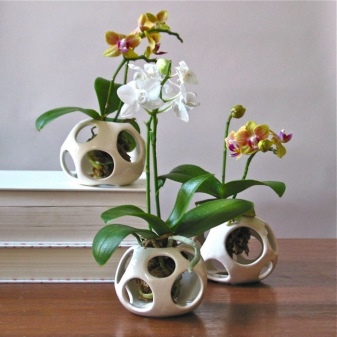
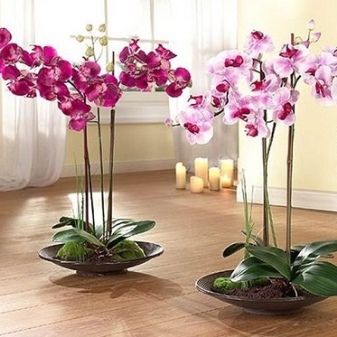
A number of requirements are imposed on containers for plants with an open root part:
- ensuring a good outflow of moisture;
- active subaeration and ventilation of rhizomes;
- maintaining a suitable temperature regime.
The root system of certain orchid species is directly involved in photosynthesis. This means that it is important for such flowers to be kept in a completely transparent vessel. And you need to choose the appropriate planter with a pot. Epiphytic plants do not need a large volume of substrate, therefore, they do not need a large container.
The only condition is the presence of drainage in it in the form of holes on the walls and bottom. The height of the container should correspond to the width of the neck, and the volume should correspond to the root part.
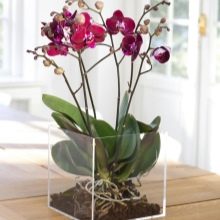
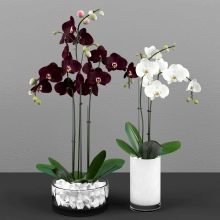

Views
There are many containers for growing orchids on sale. It remains to figure out which options can be considered the most suitable, and what may not even be considered for planting plants of this type.
- Suspended structure with pots. It is a modern solution that allows you to conveniently arrange flowers in the interior. This is ideal if there are cats or small children in the house. Hanging orchids will be out of reach and look great. It is also important to choose the right side for placing the pots, given the fact that plants cannot tolerate direct sunlight and heat. East or west would be the ideal direction for hanging orchids.
- Double table pot for paired planting of orchids. This is a very fashionable and effective solution for planting orchids. The container for the substrate is selected from plastic and placed in a beautiful rectangular or oblong oval planter.
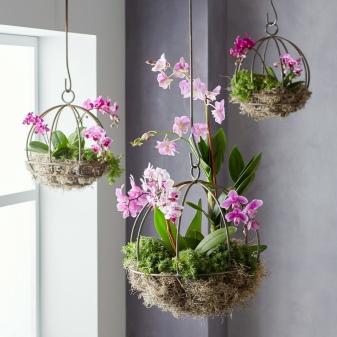
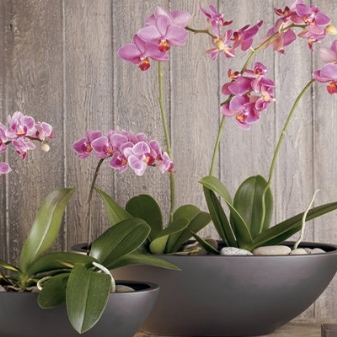
There can be many models of a decorative vessel: on legs, in the form of a plate, boat, wooden or bamboo box. Material - ceramics, clay, glass. The color can be any suitable for the design, but it is better to choose transparent or translucent flowerpots.
- Pot of unusual configuration "Crown" - a specific product with a pallet, designed exclusively for orchids. It is difficult to call this container a pot, since it is a palisade made of plastic rods attached to a disc base. There are slots between the rods that allow for easy ventilation. The pallet is connected to the container with grooves. The container itself rises slightly above the level of the bottom of the pallet. The water that collects in it evaporates and maintains a humid microclimate around the flower.Any plant of this family will be comfortable in such a pot.
- Ceramic or plastic dishes with side holes for active air circulation in the roots.
- Thin pot made of soft plastic with holes, placed in a floor, table or wall-mounted planter. Does not differ in special design and decor. Usually produced by manufacturers transparent in whole or in part.



Materials (edit)
The pot material matters when it comes to a demanding and delicate orchid. The choice of material is quite large, but it is not easy to decide, especially for novice florists.

Plastic
This is the most common and demanded material for orchid breeding. Plastic containers prevent the root part from drying out. They are easy to care for, and they are reusable, that is, they can be useful for more than one plant. In addition, the design of such a pot provides holes for the outflow of excess moisture. This means that the water will not stay in the substrate, and you will not have to worry about root decay.
If the number of drainage holes seems insufficient for the grower, he can easily make additional holes. The plastic is resistant to cool conditions and easily tolerates the sun's rays. It can be safely kept for a long time both on a lighted windowsill and in a shaded place. In any conditions, plastic will reliably protect the root system of flowers from overheating or hypothermia.
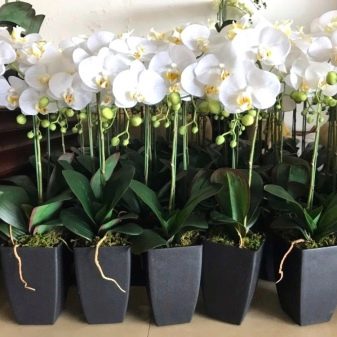

In the case of active growth of roots through the drainage holes to the outside, it is the plastic that allows the leaf outlet to be removed as carefully as possible. The flexible material is easily cut with household scissors, while the roots do not suffer at all, which cannot be done with a ceramic flowerpot.
For species whose roots are involved in photosynthesis, transparent pots are preferred. A good view of the root system opens up through the plastic - it is convenient to monitor moisture consumption and control the soil, so inexperienced growers are advised to plant orchids in such containers.
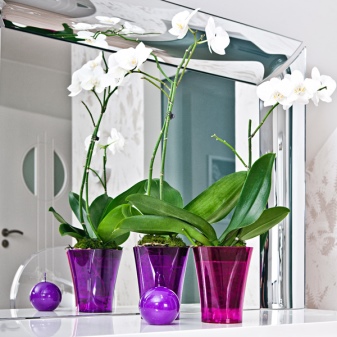

Clay
Unglazed clay pots are distinguished by excellent air and moisture permeability. After watering, moisture does not drain into one place, but spreads evenly over the substrate. The roots are protected from drying out and overheating for a long time. But, despite such obvious advantages, this type of containers has its drawbacks:
- roots often stick to the porous walls of a clay container, which entails injuries to plants during transplantation and reproduction;
- over time, the material loses its porosity due to salts that penetrate the pores of the clay and badly affect the health of the flower.
When planning to use an earthen vessel, it is important to understand how to properly plant an orchid there. Before planting, the container must be thoroughly disinfected: warm it up in the oven and soak it for 2 hours in clean cool water.
If you plan to plant a plant in a used pot, then it will be useful to hold it in water slightly acidified with vinegar. This approach will help prevent salt streaks from appearing on it.



Glass
There is a heated debate between florists and amateur florists about whether orchids can be planted in glass vessels. Connoisseurs of this material claim that they are ideal in low humidity, but with a thick drainage layer to prevent waterlogging of the root part. Opponents are firmly convinced that stagnation of moisture and further death of the plant is ensured in such a container. Hence the conclusion: glass options are successful only for certain types of plants, for example, for vanda. This flower will develop aesthetically and harmoniously behind transparent glass.
But even with sufficient drainage and air exchange, glass has two serious drawbacks:
- accumulation of condensate on the inner surface;
- overgrowth of green algae in the root.


To prevent this from happening, it is important to replace the substrate at least twice a year. And if it is not difficult to choose a plastic container by size, then difficulties arise with glass. For example, phalaenopsis, which prefers tightness in the root, is difficult to identify in a pot that is suitable in size.
In this case, it is wiser to refuse glass, as it can injure the orchid and prevent the roots from breathing. It is better to place the plant itself in transparent plastic, and use a glass vessel as a stylish planter.



Ceramic
This is an alternative to the clay version. Ceramics hold moisture well, glazed inner walls do not allow roots to grow to them and get damaged. But this container also has disadvantages: there is no aeration and the ability to track the condition of the soil and roots. To grow an orchid in a ceramic pot, you need to take care of good drainage and ensuring proper watering. And these skills come only with the skills of growing and are inherent only to professionals.
Planting an orchid in such a pot requires some procedures. The purchased product must be sterilized in the oven, and the previously used container should be held in acidified water to avoid salt stains. Unfortunately, as a result of watering and feeding, such dishes will become salted, which reduces aeration - this will lead to diseases, and sometimes even to the death of the plant.


In addition, unlike clay and transparent pots, which generate heat in themselves, ceramic vessels, on the contrary, share it. In a hot room, such a container will come in handy, while it is not recommended to put a flower pot on a windowsill in winter.
Orchids in openwork Chinese ceramic pots look especially attractive. The flowerpots with legs resemble graceful baskets. In them, the roots of the flower breathe perfectly, although the earth dries out faster. It is required to control the level of its moisture.


Wicker
These containers are an excellent compromise between man-made and natural materials. For manufacturing, bamboo or wood with plastic elements is often used. There are rattan and willow baskets, ideal for free root development.
In a wicker pot, optimal conditions are created for the favorable growth of the orchid. The porous structure does not promote stagnation of water in the pot and creates a good air exchange. You have to water the plant in an openwork pot more often.


Dimensions (edit)
For the active growth of the orchid and its flowering, in addition to the material, the size of the pot is important. Too large containers are not suitable for the plant, so you should prefer compact containers, where the entire root part will fit.
It is worth paying attention to the height of the pot, which should be equal to its diameter. A loose container promotes an uneven flow of moisture to the roots, which leads to their rotting. A tall and narrow vessel often collapses due to structural instability. A long and shallow flowerpot is a smarter solution for placing orchids. Choosing the most comfortable container for the orchid, it is better to dwell on the one in which the plant will be located a little cramped.





While they are definitely demanding, orchids thrive in a wide variety of containers. It is reasonable to inquire in advance about the type of orchid being purchased and choose the most suitable option from the pots.
For the "kids" of the orchid, a mini-container is usually selected, designed for growth up to a year. You can use a plastic cup or cotton ball jar. Any small plastic container will also work. The main thing is to choose it taking into account the further growth of the new generation and do not forget to make holes for moisture removal and ventilation in the root part.

Options
The process of caring for orchids is facilitated by modern fixtures in the form of options for pots.
- Automatic watering. When breeding phalaenopsis hybrid varieties, flower lovers often prefer watering automation. The auto-irrigation option is available to everyone when purchasing factory pots, but many growers equip it on their own. This option is convenient because it saves time, and automatic watering settings are not difficult. The device with pallets is especially appreciated. It is required for those who are forced to often leave the house. Plants receive a sufficient amount of moisture in the absence of caring owners.
- Pots with phyto-lighting. For orchids, containers with additional lighting are sold, which is quite convenient in the evening and at night. The illuminated orchid greenhouse looks great and replaces the finest garlands and nightlights. Even the simplest flower pot looks spectacular and unusual in lighting.


How to choose?
The optimal pot for an orchid needs to be selected according to some parameters. They will be discussed below.
- Moisture at the roots should not stagnate in it. The bottom and sides should be holes.
- Active aeration of the plant and the substrate should be provided, which makes it possible to obtain an optimal thermal regime.
- Rhizomes that tend to spread beyond the walls of the pot must be removed safely.
- For the root system of some species, sunlight is important. This means that the container must be completely transparent (especially for phalaenopsis).
- Even a large orchid will grow best in a small pot with little substrate.
- The height of the pot should be equal to the diameter of the neck, and the rhizomes should fit entirely inside.



An excellent choice for planting orchids will be a Fiji polypropylene pot. Special drainage holes were originally made in it. The outer beauty is provided by a planter to match the inner pot.
The plant is planted in a pot and placed in a flower pot. Having a pallet saves time spent on flower care. When watering, the water does not leak, and thanks to the legs at the bottom of the pot, an air space is created in the planter.


Interesting examples
Many housewives themselves make unusual and beautiful pots for orchids. A standard plastic or ceramic pot is placed inside. This is a stylish solution that does not require a lot of money, you just need to devote time to the process and connect your imagination. Materials for homemade pots can be bamboo sticks twisted around the base with copper wire or planted with glue. Ordinary transparent fishing line is also suitable for fastening.


Hanging planter
Growing orchids in hanging planters is an interesting option. Due to its asymmetric growth and high growth, the suspended plant does not fall over. Hanging it looks more natural. The main condition that must be met is to provide him with active aeration of the root system and sufficient illumination. The flower pot is placed in the pots so that a finger is placed between their walls.
It is advisable to hang the planter near the window, providing the plant with the daylight it needs. You also need to control the moisture level of the root system. A window sill on the east or west side will be ideal for placing orchids. You can also hang the pots in the shade, but then you will have to take care of additional lighting that compensates the plants for the lack of light.



Rooting flowers on snags
With the help of a stand, driftwood, a large branch of an orchid, two or more pieces are placed. Experts in the field of floriculture give reviews about this method of growing. The roots of the plant must be wrapped in moss and attached to the stand with wire. The orchid is placed in the shade for 1-2 weeks, and then determined to the place of permanent deployment.
It will not be easy for beginners to determine the degree of moisture of the roots of a plant on stumps - it is better for them to plant orchids in pairs in one pot and create a simpler floral installation.And professional growers are able to grow miniature specimens even in terrariums and on trays with pebbles.

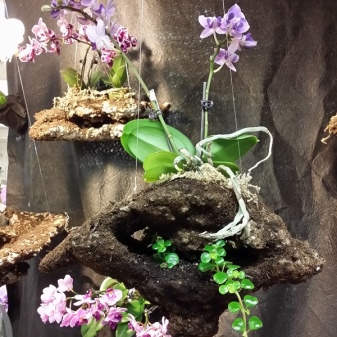
Fiji matte flower pots with tray and pots
This is an option for those who like inexpensive decoration and easy plant care. Many colors are available in delicate and juicy shades. In lightweight plastic, additional holes for drainage are easily made. The planter has a stable base and does not emit a toxic odor.


"Crown" for luxurious orchids
This device is a real royal gift for this plant. It takes into account all the nuances for the ideal development of orchids inside. A palisade made of durable plastic ensures air circulation and does not create stagnant moisture. The drip tray retains some water to keep it moist. The roots fit perfectly into the container and can "breathe" through the decorative slits.
A special pot for an orchid is more expensive than the standard version, while you need to choose such an accessory according to your own measurements and capabilities.


For information on how to choose the right pot for an orchid, see the next video.













The comment was sent successfully.